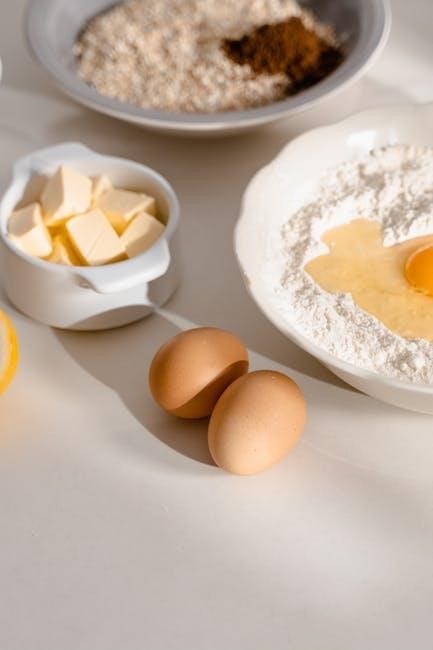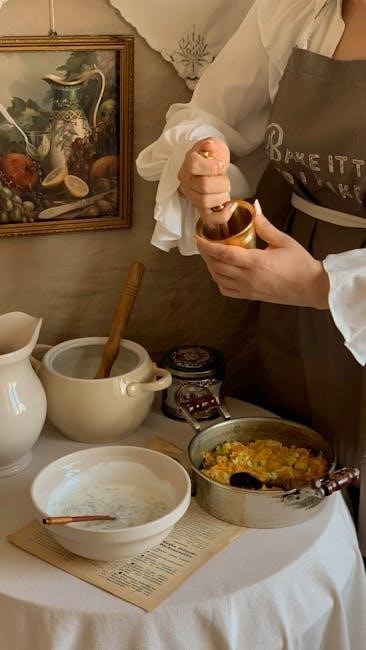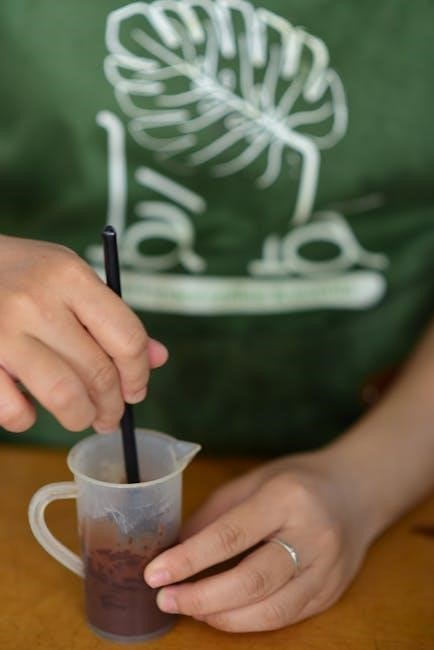
Permethrin 13.3 is a versatile insecticide used for pest control, clothing treatment, and outdoor applications. Proper mixing ensures effectiveness and safety, avoiding over- or under-dilution risks.
Overview of Permethrin 13.3
Permethrin 13.3 is a multi-purpose insecticide concentrate widely used for pest control, clothing treatment, and outdoor applications. It is available in a 13.3% permethrin solution, making it a popular choice for both household and agricultural use. The product is known for its effectiveness against ticks, lice, and other pests. It can be applied using handheld foggers or automatic misting systems, offering flexibility in application methods. One quart of Permethrin 13.3 can make up to 48 gallons for contact and residual sprays, making it a cost-effective solution. Its versatility extends to treating carpets, bedding, and clothing, ensuring comprehensive pest protection. Proper mixing is essential to achieve desired results while maintaining safety standards.
Importance of Proper Mixing
Proper mixing of Permethrin 13.3 is crucial for ensuring its effectiveness and safety. Incorrect dilution can lead to reduced efficacy or potential harm to people, pets, and the environment. Over-dilution may fail to eliminate pests, while under-dilution can pose health risks. Following the recommended mixing ratios, typically 0.25% to 0.50% concentration, ensures optimal performance for specific applications, such as tick control or household pest management. Adhering to the product label instructions guarantees safe and effective use, minimizing risks and maximizing results. Proper mixing also prevents environmental contamination, making it a critical step in responsible pest control practices.

Purpose and Functionality
Permethrin 13.3 serves the purpose of tick control and pest management by functioning as a key barrier on outdoor surfaces and fabrics to repel and eliminate pests efficiently and effectively.
Primary Purpose of Permethrin 13.3
Permethrin 13.3 is primarily designed for tick control and insecticide applications, serving as a concentrated formula to be mixed with water for effective pest management. Its main function is to create a strong barrier against ticks, mosquitoes, and other pests, particularly in outdoor environments. The 13.3% concentration makes it a potent active ingredient for treating clothing, gear, and surfaces to repel and kill pests. By following proper mixing instructions, Permethrin 13.3 ensures long-lasting protection and prevents tick-borne illnesses. It is widely used in camping, hunting, and outdoor activities to safeguard individuals from pest-related risks. Proper application and dilution are essential for maximizing its effectiveness and safety.
Applications and Uses
Permethrin 13.3 is widely used for controlling ticks, mosquitoes, and other pests in various settings. It is commonly applied to clothing, gear, and outdoor equipment to repel insects. This concentrate is also used in agricultural settings to protect crops from pests and in public health campaigns to control mosquito populations. Additionally, it is applied to livestock to prevent insect infestations. Its versatility makes it a popular choice for camping, hunting, and outdoor activities, ensuring protection against tick-borne illnesses. Properly mixed Permethrin 13.3 is effective for treating surfaces, gear, and fabrics, making it a essential tool for pest management in both personal and professional contexts.

Safety Precautions
Wear protective gloves, eyewear, and clothing to avoid skin contact. Ensure good ventilation and avoid mixing near food or water sources. Follow label instructions carefully.
General Safety Guidelines
Always handle permethrin 13.3 in a well-ventilated area, away from food, water, and pets. Avoid breathing in the mist or vapors during mixing. Use a clean, chemical-resistant surface for mixing, and keep the area clear of flammable materials. In case of spills, contain the liquid immediately to prevent environmental contamination. Never mix permethrin 13.3 near open flames or sparks. Follow the product label instructions precisely to ensure safe handling and application. Dispose of unused mixture and empty containers according to local regulations. Keep the product out of reach of children and unauthorized individuals. Proper precautions will minimize risks to humans, animals, and the environment.
Personal Protective Equipment (PPE)
When mixing permethrin 13.3, wear appropriate PPE to minimize exposure risks. Use long-sleeved shirts, long pants, and closed-toe shoes to cover skin. Durable, chemical-resistant gloves are essential to prevent hand contact. Goggles or safety glasses protect eyes from splashes. A face mask or respirator is recommended to avoid inhaling fumes. Ensure all PPE fits properly and is in good condition. Avoid loose clothing that could get caught in equipment. Follow the manufacturer’s guidelines for PPE recommendations specific to permethrin 13.3. Proper use of PPE ensures safe handling and reduces the risk of adverse health effects during the mixing process.

Application Methods
Permethrin 13.3 can be applied using sprayers or foggers for even coverage. Follow manufacturer guidelines for equipment setup and calibration to ensure proper application rates and safety.
Handheld Foggers
Handheld foggers are portable devices used to apply Permethrin 13.3 solutions in outdoor or indoor spaces. Always mix the product according to label instructions before filling the fogger. Shake the mixture well to ensure even distribution. Hold the fogger 18-24 inches away from the target area and move it steadily to avoid over-application. Avoid breathing in the fog and keep people and pets away during use. After application, allow the area to dry completely before re-entry. Handheld foggers are ideal for treating small to medium-sized areas, such as patios, gardens, or camping gear. They provide quick coverage and effective pest control.
Automatic Misting Systems
Automatic misting systems are ideal for large-scale applications of Permethrin 13.3, offering consistent and efficient coverage. Before use, mix the product according to the label instructions and pour the solution into the system’s reservoir. Ensure the dilution rate is accurate to maintain effectiveness and prevent overuse. Check the nozzles and tubing for clogs to ensure proper mist distribution. Program the system to mist at intervals suitable for your needs, typically during early morning or late evening to avoid direct sunlight. Regularly inspect and clean the system to prevent clogging and maintain performance. Automatic misting systems are perfect for barns, stables, or outdoor recreational areas, providing long-lasting pest control with minimal effort.

Concentration and Dilution Rates
Permethrin 13.3 is typically mixed at a 1% concentration for most applications. Always follow the product label for specific dilution rates to ensure effectiveness and safety. Accuracy is key to avoid over-dilution.
Standard Dilution Rates
Permethrin 13.3 is typically mixed at a concentration of 1% for general use, which equates to 1 gallon of Permethrin 13.3 in 100 gallons of water. For smaller quantities, 6.4 ounces of Permethrin 13.3 should be mixed with 1 gallon of water. Always measure accurately to maintain the recommended concentration. The standard dilution rate ensures optimal effectiveness while minimizing risks to people, animals, and the environment. Proper mixing prevents under-dilution, which may reduce efficacy, or over-dilution, which could lead to phytotoxicity or other issues. Adhering to these rates is essential for safe and successful applications in pest control, agriculture, or public health settings.
Adjusting Concentration for Specific Needs
Permethrin 13.3 concentration can be adjusted based on the target pest, surface type, or environmental conditions. For heavy infestations or hard-to-reach areas, the concentration may be increased to 2%, using 2 gallons of Permethrin 13.3 in 100 gallons of water. For delicate surfaces or plants, a lower concentration of 0.5% is recommended to avoid damage. Always follow label instructions and test a small area before applying. Adjustments should prioritize efficacy while minimizing potential risks to humans, animals, or vegetation. Proper calibration ensures the solution remains effective without causing unintended harm. Consult local guidelines or professionals for tailored recommendations.

Clothing and Fabric Treatment
Permethrin 13.3 is widely used for treating clothing and fabrics to repel insects. It’s effective against ticks, mosquitoes, and other pests, ensuring long-lasting protection. Proper application ensures safety and durability.
Mixing for Clothing Application
For clothing treatment, mix 4-6 ounces of Permethrin 13.3 per gallon of water. Ensure the solution is well-stirred to maintain uniform concentration. Apply the mixture evenly to fabrics using a spray bottle or immersion method. Allow the treated clothing to air dry completely before use, as permethrin activates upon drying. Avoid applying to damp or wet fabrics, as this reduces efficacy. Always wear gloves and work in a well-ventilated area to minimize exposure. Retreat clothing after washing, as permethrin binds to fabric but may degrade with repeated laundering. Proper mixing ensures long-lasting insect repellency and safety for the wearer.
Safe Application on Fabrics
When applying permethrin 13.3 to fabrics, ensure the solution is fully dry before contact with skin or surfaces. Avoid inhalation of the mist during application. For best results, treat fabrics in a well-ventilated area, wearing gloves and protective eyewear. Permethrin 13.3 is safe for most fabrics, but test a small, inconspicuous area first to confirm compatibility. Avoid applying to silk, wool, or nylon, as these materials may not hold the treatment effectively. Treated fabrics should be stored in a dry, cool place away from direct sunlight. Reapply after washing, as effectiveness diminishes with laundering. Always follow label instructions for fabric treatment.

Pest Control and Tick Prevention
Permethrin 13.3 is highly effective for controlling pests and preventing ticks. As a strong insecticide, it repels and kills ticks, mosquitoes, and other pests; Ideal for outdoor use, it protects gear and surfaces from infestations, ensuring long-lasting protection in high-risk areas. Its potent formula makes it a popular choice for campers and outdoor enthusiasts seeking reliable pest control. Properly mixed solutions ensure optimal performance against pests, safeguarding both people and environments from tick-borne diseases and nuisance insects; Always follow mixing instructions to maximize its effectiveness in pest control and tick prevention scenarios.
Effective Mixing for Tick Control
For effective tick control, mix Permethrin 13.3 according to the label instructions to ensure proper concentration. Typically, 1-2 ounces of Permethrin 13.3 is added to 1 gallon of water. This solution is ideal for treating outdoor gear, clothing, and surfaces to repel and kill ticks. Even application is crucial to maximize effectiveness. Avoid over- or under-dilution, as this can reduce its potency or pose environmental risks. When mixed correctly, the solution forms a long-lasting barrier against ticks, making it essential for areas with high tick activity. Always mix in a well-ventilated area and apply uniformly to targeted areas for optimal tick control results.
Application Rates for Pest Control
Permethrin 13.3 is applied at specific rates to ensure effective pest control while minimizing environmental impact. For general pest control, mix 1-2 ounces of Permethrin 13.3 with 1 gallon of water, yielding a 0.5%-1% solution. This concentration is suitable for treating surfaces, outdoor areas, and equipment. For severe infestations, the rate may increase to 3 ounces per gallon, but this should be used cautiously. Always follow label guidelines to avoid over-application, which can harm beneficial insects or contaminate water sources. Apply uniformly to target areas, ensuring complete coverage for optimal pest control results. Reapply as needed, typically every 30 days, to maintain effectiveness against pests.
Equipment and Tools Needed
- Measuring cups or graduated cylinders for precise dilution.
- Mixing containers with clear measurement markings.
- Stirring tools like sticks or electric mixers.
- Gloves, goggles, and masks for safety.
- Handheld sprayers or foggers for application.
Recommended Sprayers and Foggers
When mixing Permethrin 13.3, it’s essential to use appropriate equipment for effective application. Handheld sprayers with adjustable nozzles are ideal for small-scale treatments, allowing precise control over output. For larger areas, consider backpack sprayers or portable foggers, which cover more ground efficiently. Automatic misting systems are also suitable for consistent, long-term pest control. Ensure the equipment is designed for insecticides to prevent clogging or chemical incompatibility. Always clean and maintain sprayers to avoid residue buildup and ensure optimal performance. Properly calibrated equipment guarantees accurate application rates, maximizing the product’s effectiveness while minimizing waste.
Measuring Tools for Accuracy
Accurate measurement is critical when mixing Permethrin 13.3 to ensure safety and effectiveness. Use a clean, graduated measuring cup or container specifically designed for pesticides to prevent contamination. Digital scales are highly recommended for precise measurements, especially when dealing with larger quantities. Always calibrate your tools before use to maintain accuracy. Double-check measurements by using multiple tools if possible. Proper measurement prevents over- or under-dilution, which can lead to reduced efficacy or environmental risks. Keep measuring tools dedicated to pesticide use to avoid cross-contamination with food or other substances. Clean tools thoroughly after use to ensure future accuracy and safety.

Common Mixing Mistakes
Common mixing mistakes include incorrect dilution ratios, inadequate stirring, and using contaminated water. These errors can reduce efficacy and pose safety risks. Always follow instructions carefully.
Over- or Under-Dilution Risks
Over- or under-dilution of Permethrin 13.3 can lead to ineffective pest control or potential health risks. Over-dilution reduces the product’s potency, making it less effective against pests. Under-dilution increases the concentration beyond safe levels, posing risks to humans, pets, and the environment. Improper mixing can also result in uneven application, reducing the treatment’s efficacy. Always measure the product accurately using clean water to avoid these issues. Following the recommended dilution rates is critical for ensuring safety and effectiveness. Failure to adhere to guidelines may lead to treatment failure or unintended consequences. Proper mixing ensures optimal performance while minimizing risks. Always double-check measurements before application.
How to Avoid Errors
To avoid errors when mixing Permethrin 13.3, carefully measure the product and water using precise tools. Always use clean, cold water and ensure the container is free from contaminants. Follow the label instructions exactly, as deviations can lead to ineffective or unsafe solutions. Double-check calculations before mixing, especially when scaling up or down. Test a small batch to confirm consistency and potency. Document the mixing process for future reference. Avoid distractions during preparation to maintain focus. Store unused product securely to prevent accidental misuse. By adhering to these steps, you can ensure accurate and safe mixing, achieving the desired results for pest control or fabric treatment.

Environmental Considerations
Permethrin 13.3 can harm aquatic life if misapplied. Avoid spraying near water sources or where runoff may occur. Follow local regulations for disposal and use.
Impact on the Environment
Permethrin 13.3 can pose risks to aquatic life and non-target organisms if not used correctly. It is toxic to fish, amphibians, and bees, even at low concentrations. Improper mixing or over-application can lead to runoff into waterways, harming aquatic ecosystems. Soil contamination is also a concern, as permethrin can persist and affect soil microorganisms. Wildlife, such as birds and mammals, may face secondary exposure through contaminated prey or habitats. Proper disposal of unused solution and empty containers is essential to minimize environmental impact. Users must adhere to label instructions to protect biodiversity and prevent long-term ecological damage.
Proper Disposal Methods
Proper disposal of permethrin 13.3 is critical to prevent environmental contamination. Never pour unused solution down drains or sewers, as it can harm aquatic life. Empty containers should be triple-rinsed and taken to a hazardous waste collection facility. Dispose of unused permethrin 13.3 according to local regulations for hazardous waste. If spills occur, absorb the liquid with inert materials like sand or kitty litter, and dispose of the waste in sealed containers. Avoid contaminating soil or water sources. Always follow label instructions for disposal to minimize environmental impact and ensure compliance with local laws. Proper disposal protects ecosystems and public health.

Troubleshooting
Common issues with permethrin 13.3 mixing include incorrect dilution or uneven application. Check calibration of equipment, verify measurements, and ensure proper mixing time to avoid errors.
What to Do If Mixing Goes Wrong
If mixing permethrin 13.3 goes wrong, reassess the mixture immediately. Over-dilution may reduce effectiveness, while under-dilution can harm surfaces or organisms. Start over if the error is significant. For minor issues, adjust the concentration by adding more water or permethrin as needed. Always follow the product label for guidance. If applied incorrectly, rinse treated areas with clean water if safe to do so. Dispose of any unusable mixture properly to prevent environmental harm. Double-check measurements and procedures to avoid repeat errors. Consulting the product’s safety data sheet or manufacturer instructions can provide additional solutions for correcting mixing mistakes effectively. Proper adjustments ensure safety and efficacy.
Addressing Application Issues
If application issues arise, such as uneven coverage or insufficient pest control, identify the root cause. Check equipment for clogs or malfunctions and clean or replace parts as needed. Reapply permethrin 13.3 if necessary, ensuring proper dilution rates. For over-application, rinse treated surfaces with water if safe. Avoid using contaminated mixtures, as this can reduce effectiveness. If pests remain unaffected, consider adjusting the concentration within labeled guidelines. Always follow reapplication intervals specified on the product label. Proper application ensures both safety and efficacy, preventing potential environmental or health risks. Addressing issues promptly helps maintain the product’s intended performance.
Properly mixing and applying permethrin 13.3 ensures effective pest control and safety. Always follow instructions and safety precautions for optimal results.
Final Tips for Effective Use
Always follow the label instructions precisely for best results. Double-check measurements to avoid over- or under-dilution. Test permethrin 13.3 on a small area first to ensure compatibility. Avoid applying in direct sunlight or high winds to prevent drift. Store unused solution in a sealed container and dispose of it properly. Reapply as needed based on the product’s residual effect, typically every 2-4 weeks. Keep treated areas out of reach of pets and children until dry. Regularly clean and maintain equipment to ensure accurate application. By adhering to these guidelines, you maximize efficacy while minimizing environmental impact and ensuring safety. Consistency is key for long-term pest control success.
Encouragement to Follow Instructions
Adhering to the provided mixing instructions ensures optimal results and safety; Properly mixed permethrin 13.3 maximizes its effectiveness while minimizing risks to people, pets, and the environment. By following the guidelines, you avoid potential hazards like overexposure or uneven application. Consistent adherence also extends the product’s longevity and prevents pest resistance. Taking the time to mix accurately demonstrates responsibility and commitment to achieving desired outcomes. Remember, precise mixing is the foundation for successful pest control and tick prevention. Your diligence ensures the treatment works as intended, providing long-lasting protection and peace of mind. Always prioritize accuracy for the best experience.